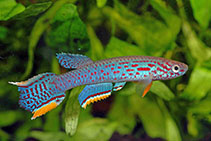| Family: |
Nothobranchiidae (African rivulines) |
| Max. size: |
3.66 cm SL (male/unsexed) |
| Environment: |
benthopelagic; freshwater, |
| Distribution: |
Africa: Sanaga River and Nyong River, Cameroon (Ref. 78443). |
| Diagnosis: |
Dorsal spines (total): 0-0; Dorsal soft rays (total): 10-12; Anal spines: 0-0; Anal soft rays: 13-15. Diagnosis: Aphyosemion lividum is distinguished from all other species of the A. calliurum-group and in particular from A. ahli by the blue-rose colour on the flanks of the body, the lines of red dots on the body and the absence of a vertical striation of red dots on the caudal peduncle (Ref. 78443).
Description: A lyre-shaped caudal fin (Ref. 78443). Scales on lateral line 28(+3)-31(+3); frontal squamation of G-type (Ref. 78443). Frontal neuromasts are open (Ref. 78443).
Colouration: For males, the dominant colour on the flanks is pinkish blue, but this colour can change depending on his mood from rose to blue; a grayish zone separates the flanks from the brownish dorsal side; the posterior part of the body is brown and light rose; the ventral side is pinkish white with bluish reflections; presence of three red opercular bands behind the eye, the superior band hardly visible; starting from the opercular bands, three discontinuous lines of red dots extend to the posterior part of the body (Ref. 78443). Dorsal fin pinkish blue with some red dots, mainly on the posterior side of the fin; anal fin pinkish blue with a line of dark dots on its basis, a dark red submarginal band and a yellow-orange marginal band are separated by a clear blue band; a lyre-shaped caudal fin with a bluish white fond colour and three to five vertical lines of red dots, a red submarginal band and a yellow-orange marginal band on the superior and inferior lobes; pelvic fins identical with anal fins; pectoral fins orange (Ref. 78443). For females: the dorsal side and caudal peduncle clear brown; ventral side yellowish white; pattern of opercular bands is identical to males, with two lines of little red dots extending to the caudal peduncle; dorsal, anal and caudal fins with bluish white reflection and without spots, with the exception of the caudal fin which has little carmine dots (Ref. 78443). |
| Biology: |
|
| IUCN Red List Status: |
Not Evaluated (N.E.) Ref. (130435)
|
| Threat to humans: |
harmless |
Source and more info: www.fishbase.org. For personal, classroom, and other internal use only. Not for publication.

